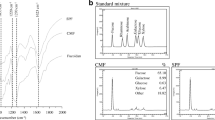Abstract
Quercetin and kaempferol, two well-known flavonols, were chemically conjugated with glucose to produce the corresponding flavonol glucosides, and the following biological activities were evaluated for cosmeceutical development: antioxidant activity, ability to increase collagen synthesis, and moisturizing activity. Among the synthetic flavonol glucosides, quercetin-3-O-β-D-glucoside significantly enhanced collagen synthesis (60 %) compared to quercetin. Kaempferol-3,7-di-O-β-D-glucoside showed promising skin-moisturizing effects, inducing a sixfold increase in the expression of aquaporin-3. Thus, both quercetin-3-O-β-D-glucoside and kaempferol-3,7-di-O-β-D-glucoside were shown to possess interesting biological activities which warrant their further development as cosmetic ingredients.






Similar content being viewed by others
References
Ardhaoui M, Falcimaigne A, Ognier S, Engasser JM, Moussou P, Pauly G, Ghoul M (2004) Effect of acyl donor chain length and substitutions pattern on the enzymatic acylation of flavonoids. J Biotechnol 110:265–271
Boury-Jamot M, Sougrat R, Tailhardat M, Le Varlet B, Bonte F, Dumas M, Verbavatz JM (2006) Expression and function of aquaporins in human skin: is aquaporin-3 just a glycerol transporter? Biochim Biophys Acta 1758:1034–1042
Caldwell ST, Petersson HM, Farrugia LJ, Mullen W, Crozier A, Hartley RC (2006) Isotopic labelling of quercetin 3-glucoside. Tetrahedron 62:7257–7265
Chang Q, Zuo Z, Chow MSS, Ho WKK (2005) Difference in absorption of the two structurally similar flavonoid glycosides, hyperoside and isoquercitrin in rats. Eur J Pharm Biopharm 59:549–555
Chondrogianni N, Kapeta S, Chinou I, Vassilatou K, Papassideri I, Gonos ES (2010) Anti-ageing and rejuvenating effects of quercetin. Exp Gerontol 45:763–771
Chuarienthong P, Lourith N, Leelapornpisid P (2010) Clinical efficacy comparison of anti-wrinkle cosmetics containing herbal flavonoids. Int J Cosmet Sci 32:99–106
dal Belo SE, Gaspar LR, Maia Campos PM, Marty JP (2009) Skin penetration of epigallocatechin-3-gallate and quercetin from green tea and Ginkgo biloba extracts vehiculated in cosmetic formulations. Skin Pharmacol Physiol 22:299–304
Haapasaari K, Rossi O, Risteli J, Oikarinen A (1998) Effects of long-term inhaled corticosteroids on skin collagen synthesis and thickness in asthmatic patients. Eur Respir J 11:139–143
Hashimoto T, Ueda Y, Oi N, Sakakibara H, Piao C, Ashida H, Goto M, Kanazawa K (2006) Effects of combined administration of quercetin, rutin, and extract of white radish sprout rich in kaempferol glycosides on the metabolism in rats. Biosci Biotechnol Biochem 70:279–281
Kubo I, Nitoda T, Nihei K (2007) Effects of quercetin on mushroom tyrosinase and B16-F10 melanoma cells. Molecules 12:1045–1056
Lee EJ, Ji GE, Sung MK (2010) Quercetin and kaempferol suppress immunoglobulin E-mediated allergic inflammation in RBL-2H3 and Caco-2 cells. Inflamm Res 59:847–854
Li G, Zeng X, Xie Y, Cai Z, Moore JC, Yuan X, Cheng Z, Ji G (2012) Pharmacokinetic properties of isorhamnetin, kaempferol and quercetin after oral gavage of total flavones of Hippophae rhamnoides L. in rats using a UPLC-MS method. Fitoterapia 83:182–191
Murota K, Mitsukuni Y, Ichikawa M, Tsushida T, Miyamoto S, Terao J (2004) Quercetin-4′-glucoside is more potent than quercetin-3-glucoside in protection of rat intestinal mucosa homogenates against iron ion-induced lipid peroxidation. J Agric Food Chem 52:1907–1912
Nirmala P, Ramanathan M (2011) Effect of kaempferol on lipid peroxidation and antioxidant status in 1,2-dimethyl hydrazine induced colorectal carcinoma in rats. Eur J Pharmacol 654:75–79
Pang JL, Ricupero DA, Huang S, Fatma N, Singh DP, Romero JR, Chattopadhyay N (2006) Differential activity of kaempferol and quercetin in attenuating tumor necrosis factor receptor family signaling in bone cells. Biochem Pharmacol 71:818–826
Ranger CM, Singh AP, Johnson-Cicalese J, Polavarapu S, Vorsa N (2007) Intraspecific variation in aphid resistance and constitutive phenolics exhibited by the wild blueberry Vaccinium darrowi. J Chem Ecol 33:711–729
Vuorinen H, Maatta K, Torronen R (2000) Content of the flavonols myricetin, quercetin, and kaempferol in finnish berry wines. J Agric Food Chem 48:2675–2680
Walgren RA, Lin JT, Kinne RK, Walle T (2000) Cellular uptake of dietary flavonoid quercetin 4′-beta-glucoside by sodium-dependent glucose transporter SGLT1. J Pharmacol Exp Ther 294:837–843
Zhang WL, Chen JP, Lam KY, Zhan JY, Yao P, Dong TT, Tsim KW (2014) Hydrolysis of glycosidic flavonoids during the preparation of danggui buxue tang: an outcome of moderate boiling of chinese herbal mixture. Evid Based Complement Alternat Med 2014:608721–608731
Acknowledgments
This research was supported by Konkuk University in 2014.
Author information
Authors and Affiliations
Corresponding author
Additional information
Kwang-Su Park, Hyungmi Kim, have contributed equally to this work.
Rights and permissions
About this article
Cite this article
Park, KS., Kim, H., Kim, M.K. et al. Synthesis and biological evaluation of flavonol-glucose conjugates for cosmeceutical development. J Korean Soc Appl Biol Chem 58, 317–323 (2015). https://doi.org/10.1007/s13765-015-0049-3
Received:
Accepted:
Published:
Issue Date:
DOI: https://doi.org/10.1007/s13765-015-0049-3




